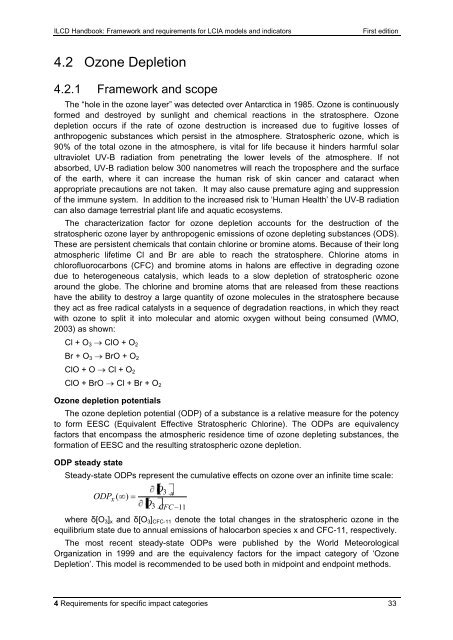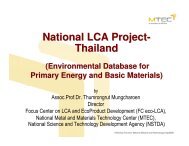ILCD Handbook: Framework and requirements for LCIA models and ...
ILCD Handbook: Framework and requirements for LCIA models and ...
ILCD Handbook: Framework and requirements for LCIA models and ...
You also want an ePaper? Increase the reach of your titles
YUMPU automatically turns print PDFs into web optimized ePapers that Google loves.
<strong>ILCD</strong> <strong>H<strong>and</strong>book</strong>: <strong>Framework</strong> <strong>and</strong> <strong>requirements</strong> <strong>for</strong> <strong>LCIA</strong> <strong>models</strong> <strong>and</strong> indicators First edition<br />
4.2 Ozone Depletion<br />
4.2.1 <strong>Framework</strong> <strong>and</strong> scope<br />
The ―hole in the ozone layer‖ was detected over Antarctica in 1985. Ozone is continuously<br />
<strong>for</strong>med <strong>and</strong> destroyed by sunlight <strong>and</strong> chemical reactions in the stratosphere. Ozone<br />
depletion occurs if the rate of ozone destruction is increased due to fugitive losses of<br />
anthropogenic substances which persist in the atmosphere. Stratospheric ozone, which is<br />
90% of the total ozone in the atmosphere, is vital <strong>for</strong> life because it hinders harmful solar<br />
ultraviolet UV-B radiation from penetrating the lower levels of the atmosphere. If not<br />
absorbed, UV-B radiation below 300 nanometres will reach the troposphere <strong>and</strong> the surface<br />
of the earth, where it can increase the human risk of skin cancer <strong>and</strong> cataract when<br />
appropriate precautions are not taken. It may also cause premature aging <strong>and</strong> suppression<br />
of the immune system. In addition to the increased risk to ‗Human Health‘ the UV-B radiation<br />
can also damage terrestrial plant life <strong>and</strong> aquatic ecosystems.<br />
The characterization factor <strong>for</strong> ozone depletion accounts <strong>for</strong> the destruction of the<br />
stratospheric ozone layer by anthropogenic emissions of ozone depleting substances (ODS).<br />
These are persistent chemicals that contain chlorine or bromine atoms. Because of their long<br />
atmospheric lifetime Cl <strong>and</strong> Br are able to reach the stratosphere. Chlorine atoms in<br />
chlorofluorocarbons (CFC) <strong>and</strong> bromine atoms in halons are effective in degrading ozone<br />
due to heterogeneous catalysis, which leads to a slow depletion of stratospheric ozone<br />
around the globe. The chlorine <strong>and</strong> bromine atoms that are released from these reactions<br />
have the ability to destroy a large quantity of ozone molecules in the stratosphere because<br />
they act as free radical catalysts in a sequence of degradation reactions, in which they react<br />
with ozone to split it into molecular <strong>and</strong> atomic oxygen without being consumed (WMO,<br />
2003) as shown:<br />
Cl + O3 ClO + O2<br />
Br + O3 BrO + O2<br />
ClO + O Cl + O2<br />
ClO + BrO Cl + Br + O2<br />
Ozone depletion potentials<br />
The ozone depletion potential (ODP) of a substance is a relative measure <strong>for</strong> the potency<br />
to <strong>for</strong>m EESC (Equivalent Effective Stratospheric Chlorine). The ODPs are equivalency<br />
factors that encompass the atmospheric residence time of ozone depleting substances, the<br />
<strong>for</strong>mation of EESC <strong>and</strong> the resulting stratospheric ozone depletion.<br />
ODP steady state<br />
Steady-state ODPs represent the cumulative effects on ozone over an infinite time scale:<br />
ODP x (<br />
)<br />
O3<br />
x<br />
O3<br />
CFC<br />
11<br />
where δ[O3]x <strong>and</strong> δ[O3]CFC-11 denote the total changes in the stratospheric ozone in the<br />
equilibrium state due to annual emissions of halocarbon species x <strong>and</strong> CFC-11, respectively.<br />
The most recent steady-state ODPs were published by the World Meteorological<br />
Organization in 1999 <strong>and</strong> are the equivalency factors <strong>for</strong> the impact category of ‗Ozone<br />
Depletion‘. This model is recommended to be used both in midpoint <strong>and</strong> endpoint methods.<br />
4 Requirements <strong>for</strong> specific impact categories 33



